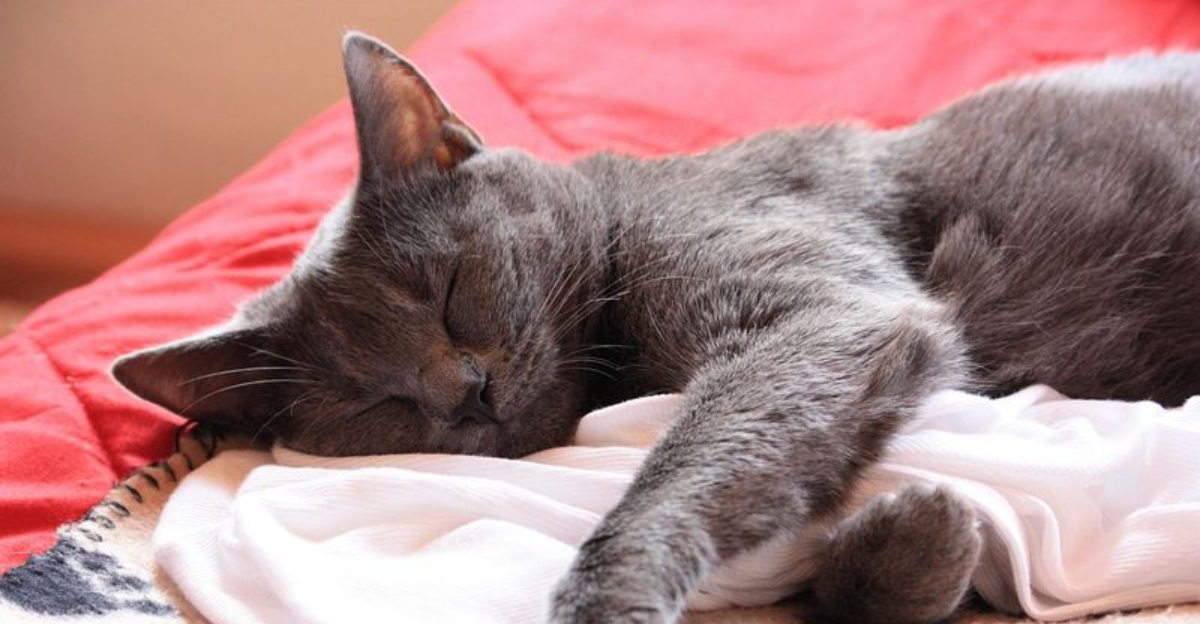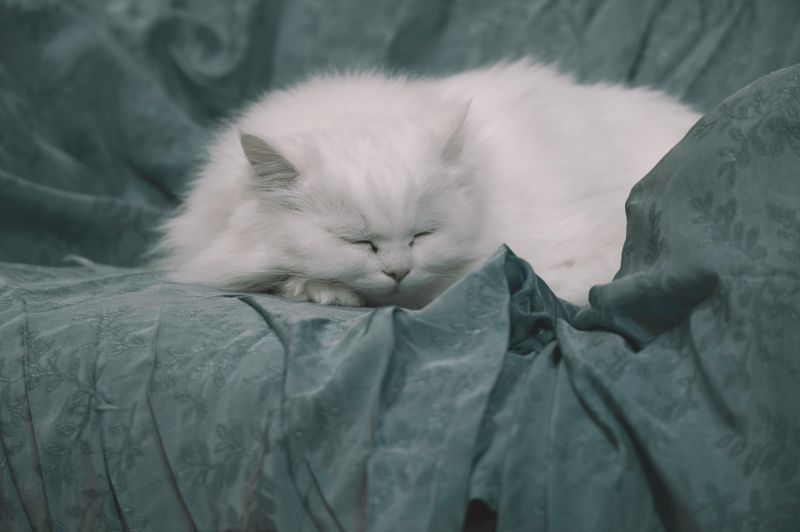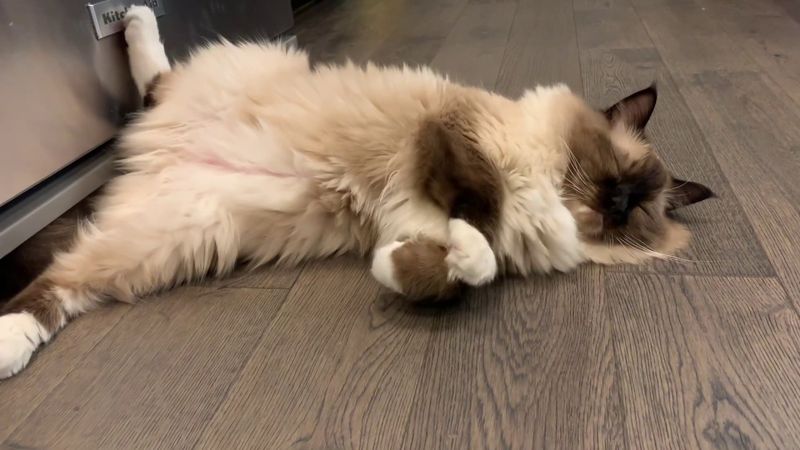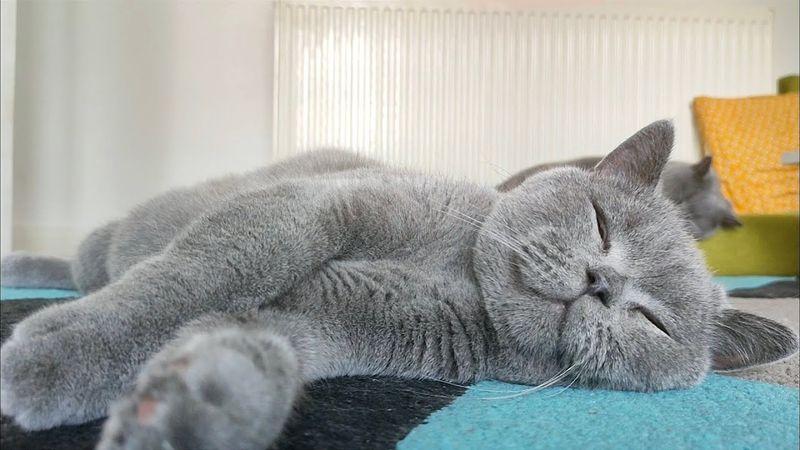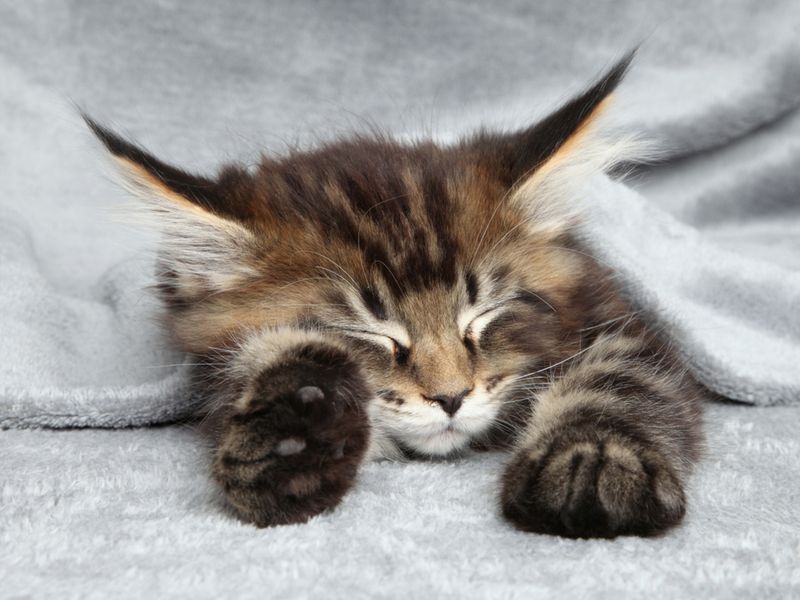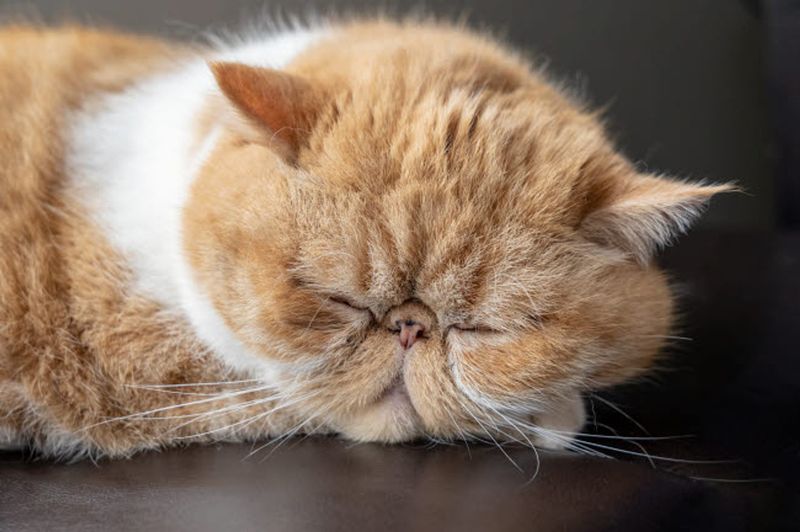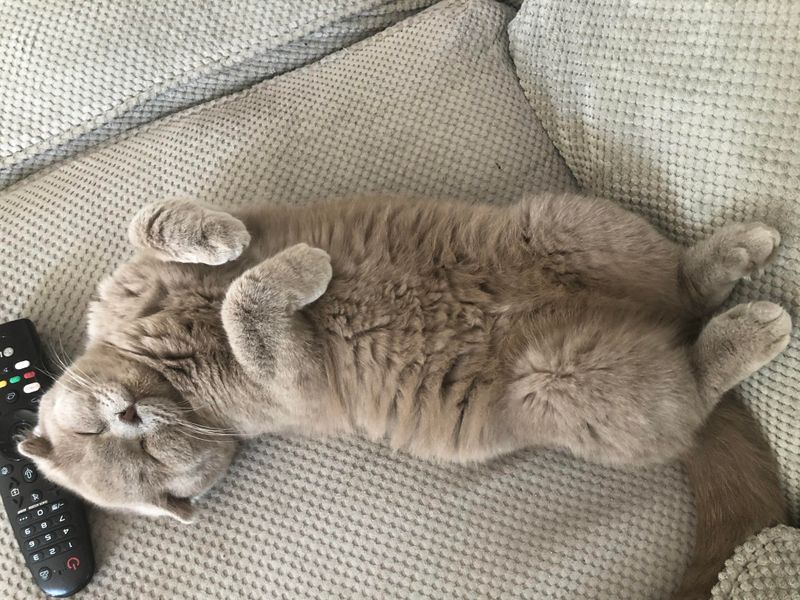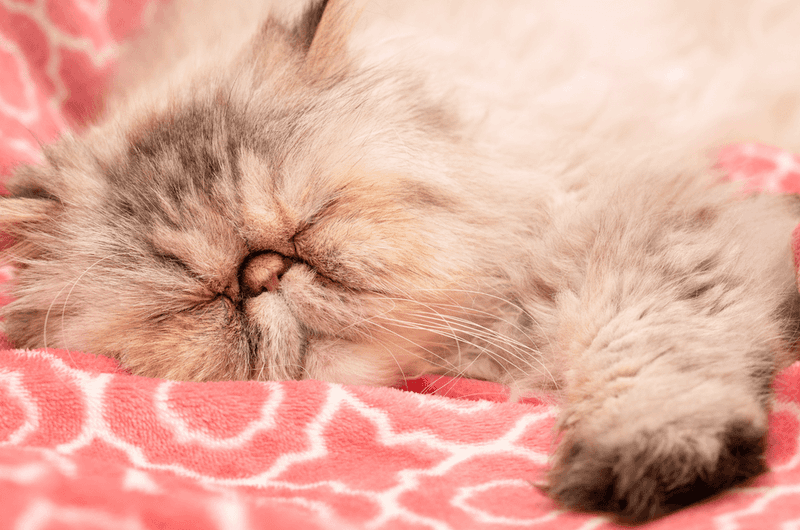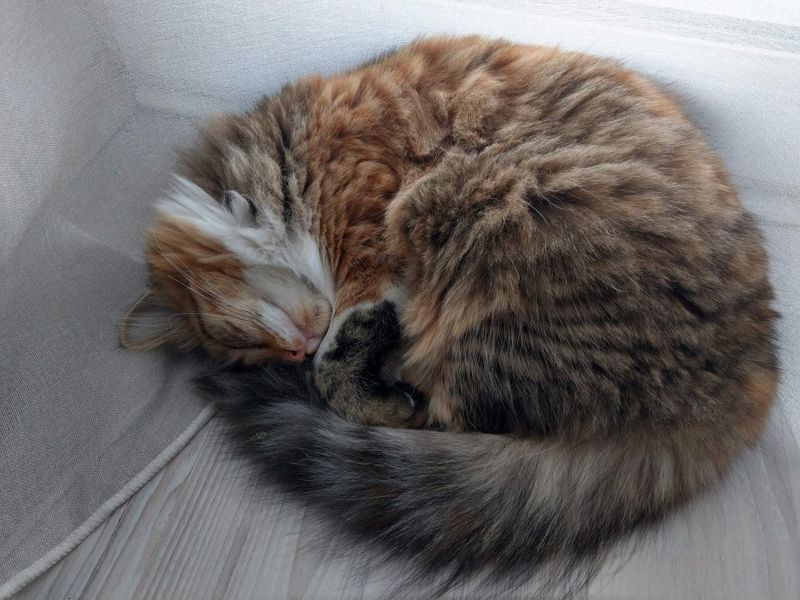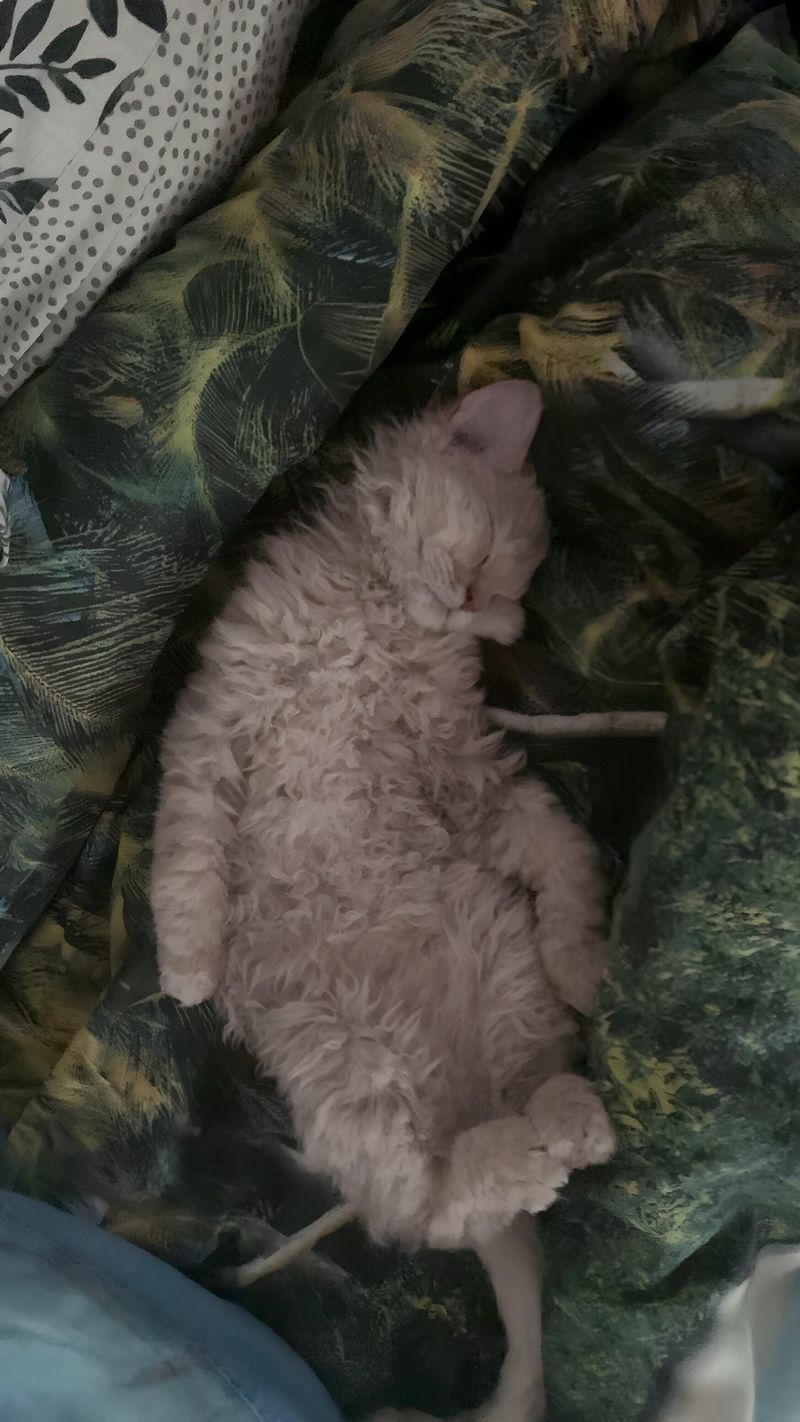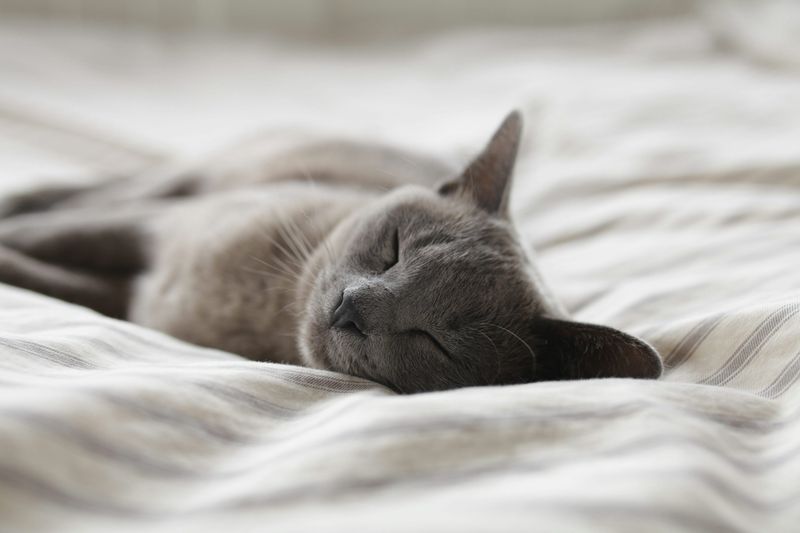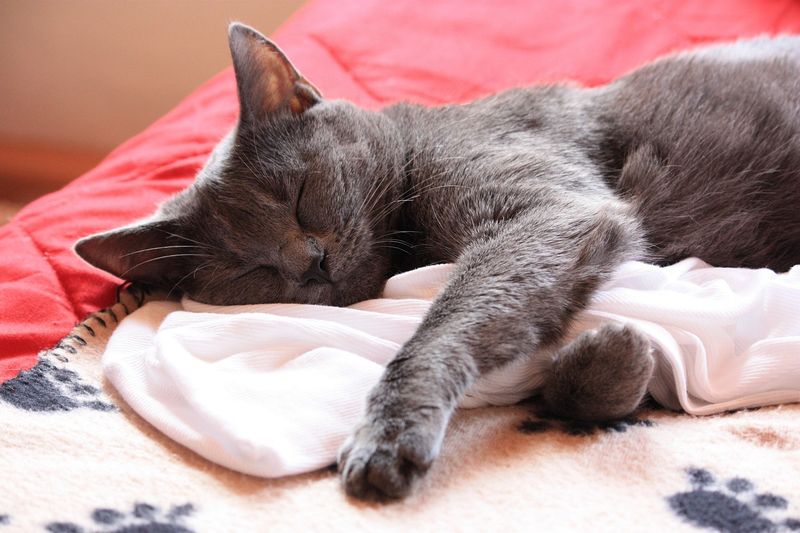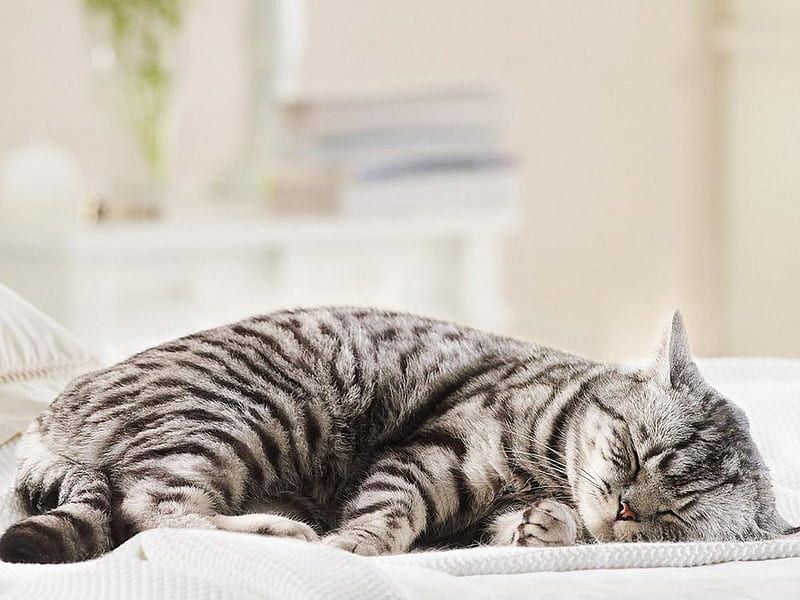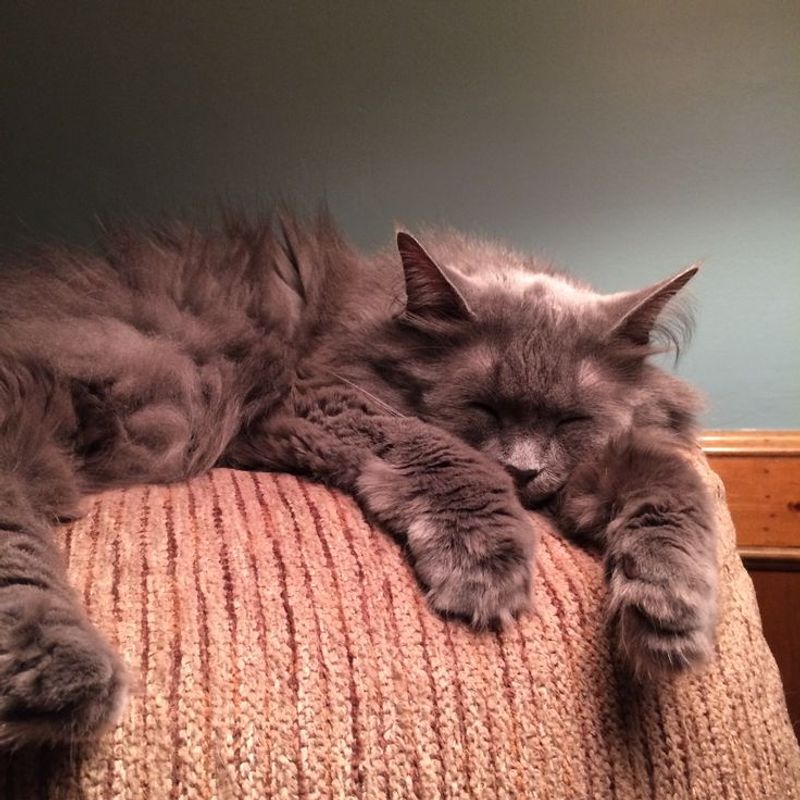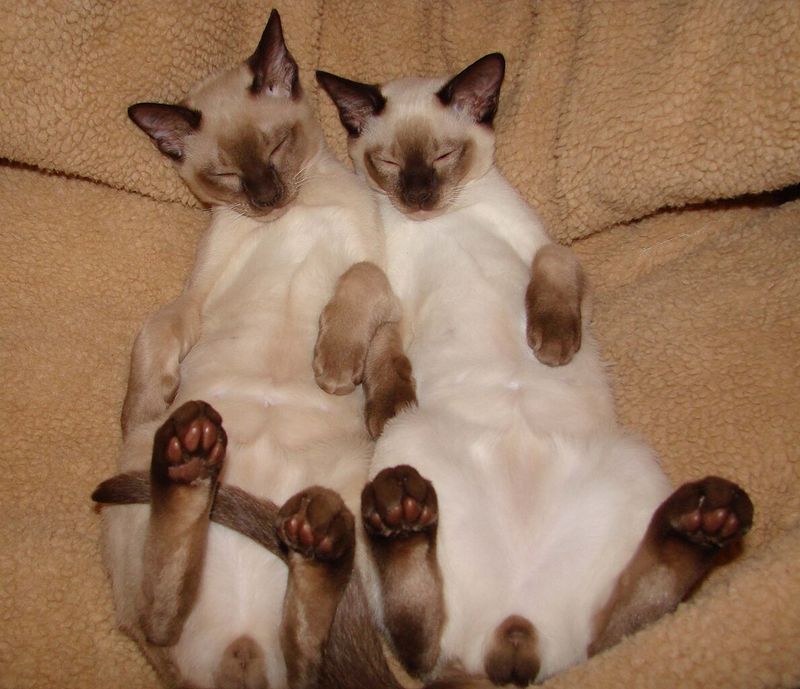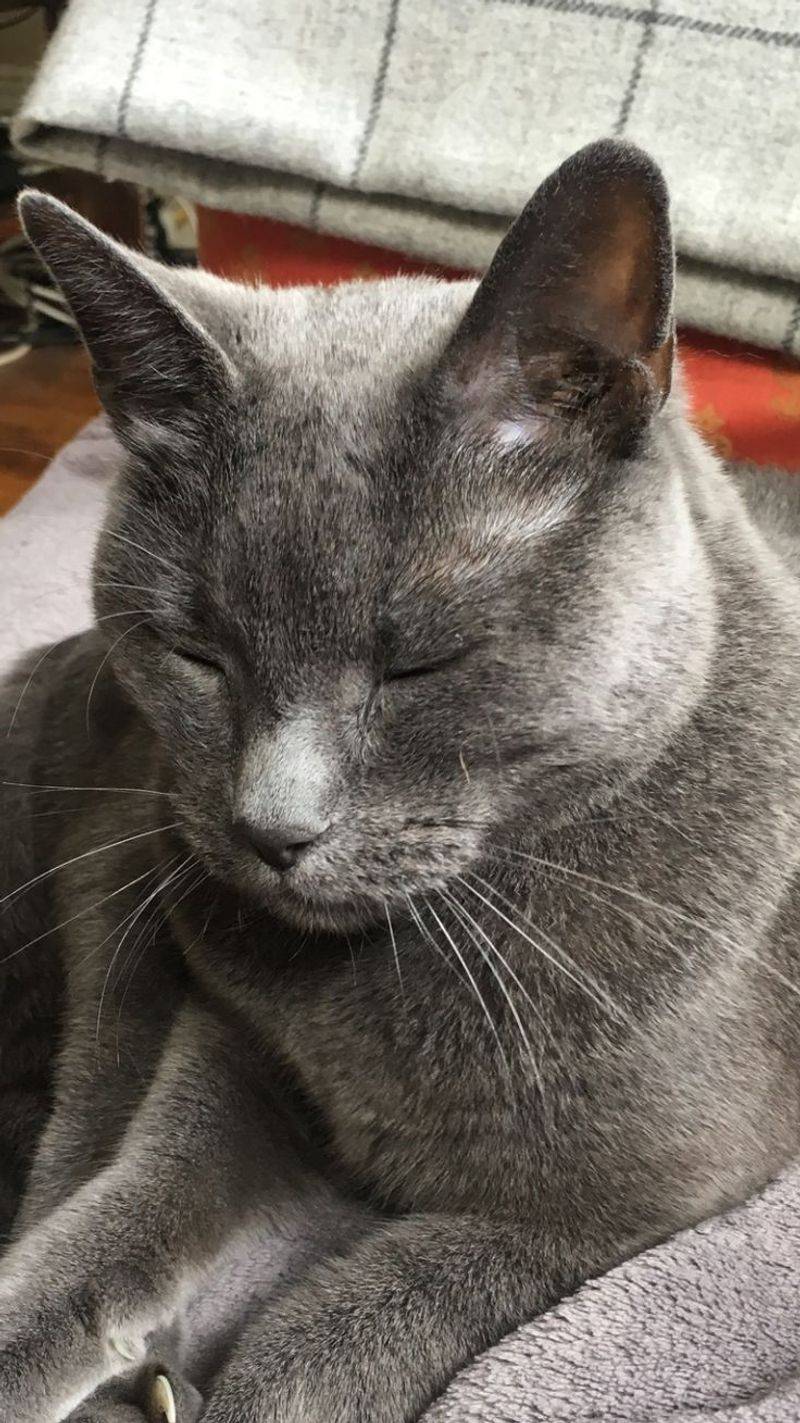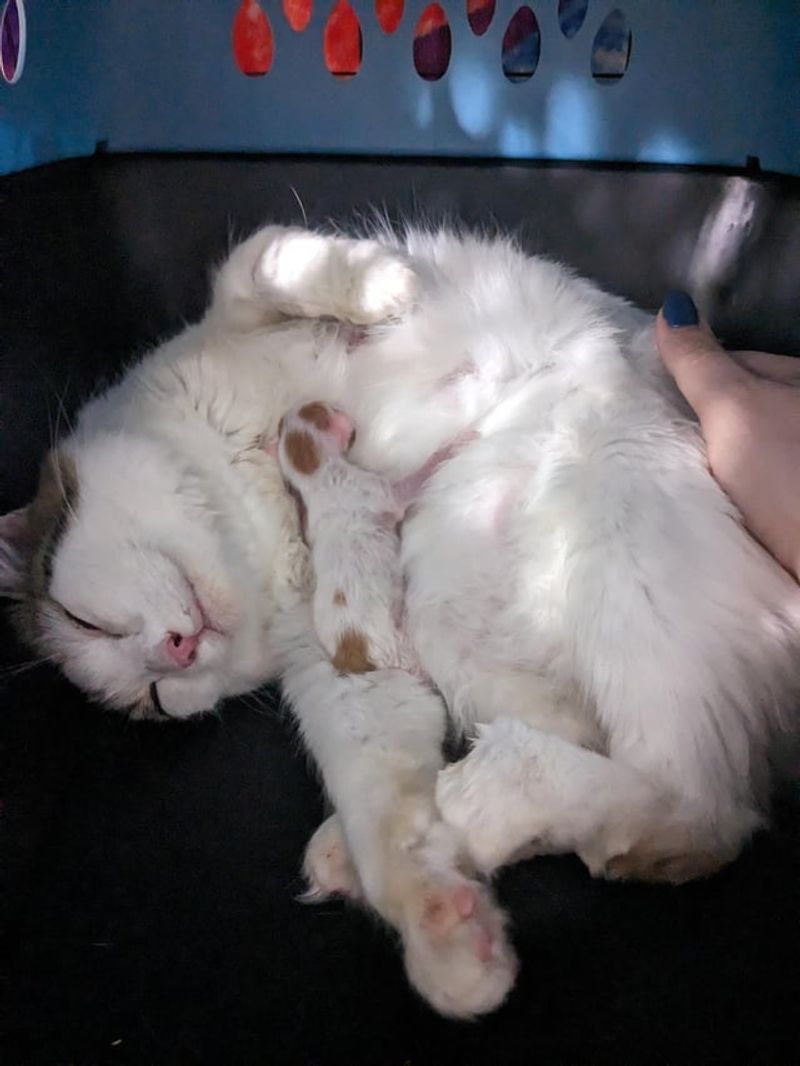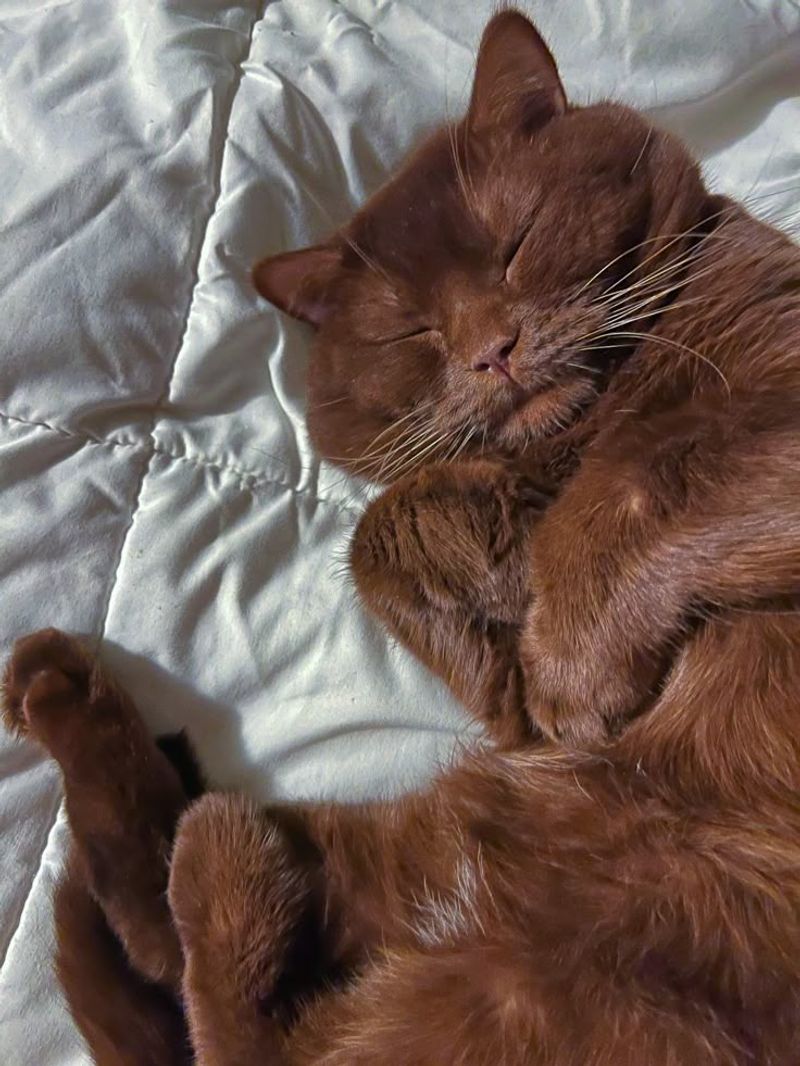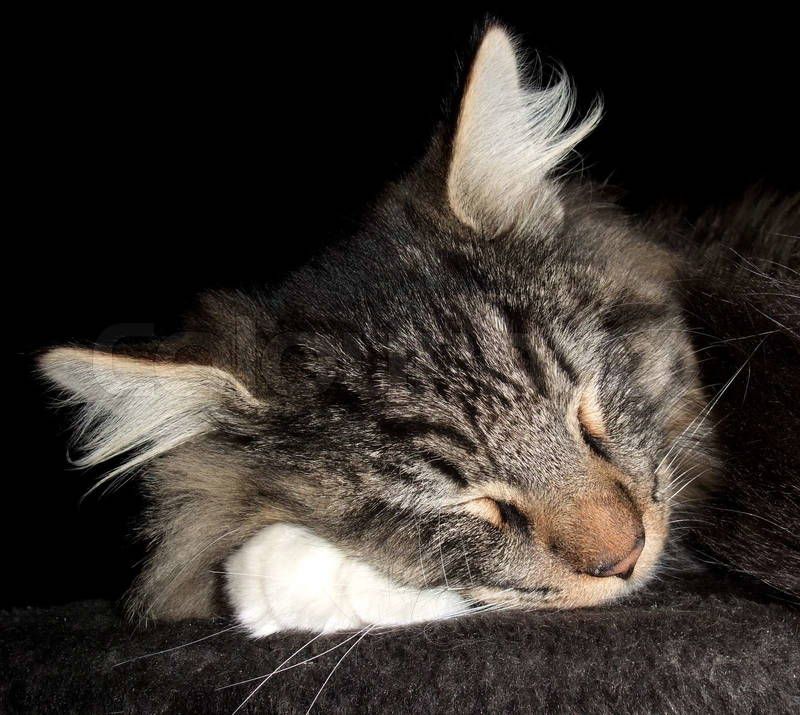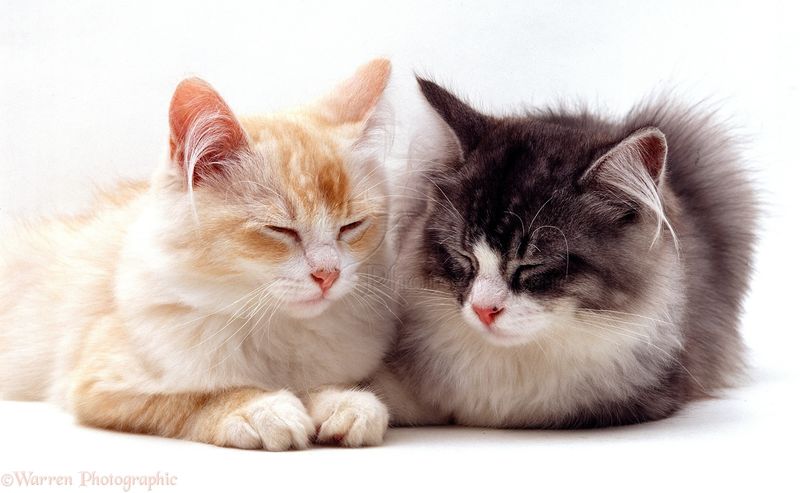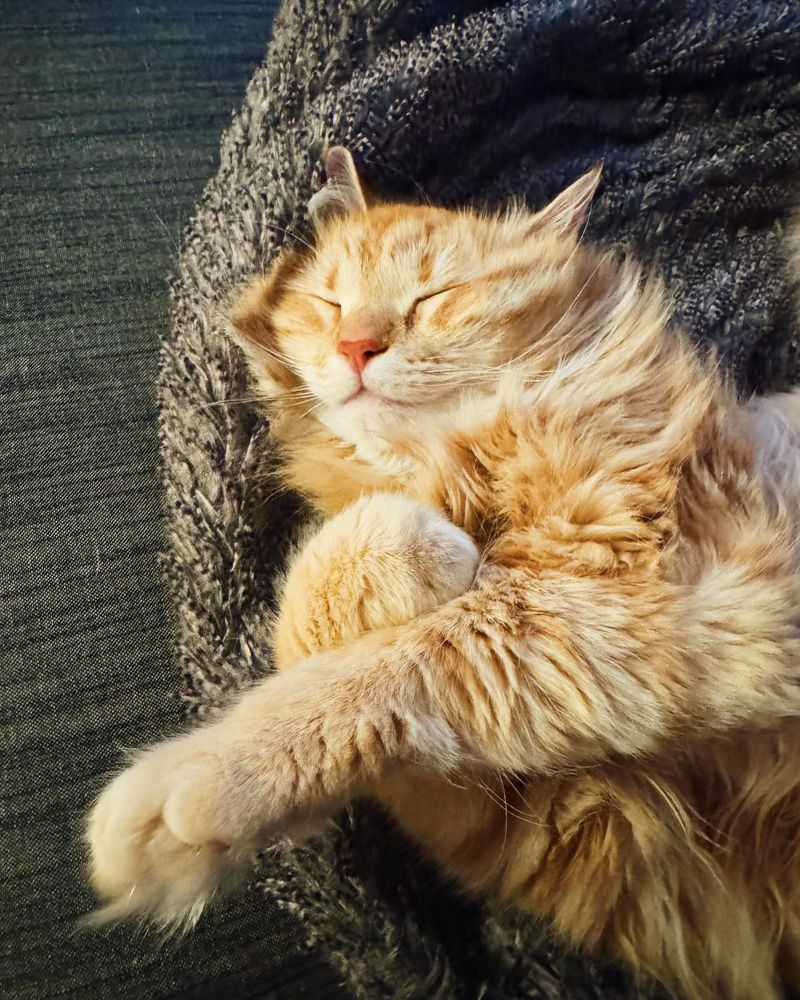📖 Table of Content:
- 1. Persian
- 2. Ragdoll
- 3. British Shorthair
- 4. Maine Coon
- 5. Exotic Shorthair
- 6. Scottish Fold
- 7. Himalayan
- 8. Ragamuffin
- 9. Selkirk Rex
- 10. Russian Blue
- 11. Chartreux
- 12. American Shorthair
- 13. Nebelung
- 14. Tonkinese
- 15. Korat
- 16. Japanese Bobtail
- 17. York Chocolate
- 18. Norwegian Forest Cat
- 19. Cymric
- 20. Siberian
Cats are famous for their love of napping, often sleeping between 12 and 16 hours daily. Some breeds, however, take this feline tendency to a whole new level, spending the majority of their time in dreamland. These champion sleepers have perfected the art of finding the coziest spots and dozing off while the world continues around them. Let’s explore the cat breeds that have truly mastered the art of sleeping.
1. Persian
Persian cats are legendary nappers who typically sleep 15-20 hours daily. Their calm, laid-back temperament makes them perfect candidates for extended snooze sessions on any comfortable surface they can find.
The thick, luxurious coat of a Persian requires significant energy to maintain, which may contribute to their need for extra rest. These cats prefer quiet environments where they can doze undisturbed.
When they’re not sleeping, Persians move slowly and deliberately, conserving energy for their next nap. Their peaceful nature and minimal activity requirements make them ideal companions for apartment dwellers or those seeking a tranquil pet.
2. Ragdoll
True to their name, Ragdolls melt into your arms like a childhood doll. Their calm, gentle spirit shows in their love for long naps, often sleeping up to 20 hours a day without a care in the world.
Known for their striking blue eyes and color-point coats, these gentle giants prefer finding a cozy spot near their humans rather than engaging in energetic play. Their docile temperament contributes to their reputation as champion sleepers.
Despite their large size, Ragdolls often seek out small, confined spaces for napping, creating adorable scenes when they squeeze into tiny boxes or baskets.
3. British Shorthair
These sleepy Brits take napping seriously—clocking up to 18 hours a day! British Shorthairs would rather nap in style than chase toys for hours.
Their dense, plush coats and sturdy bodies make them natural heat seekers during colder months. You’ll frequently find them curled into tight balls on warm laundry piles or sunny windowsills.
While not overly demanding of attention, British Shorthairs appreciate having a designated sleeping spot in each room of the house. Their independent nature means they’re perfectly content to snooze away the hours while their humans are busy.
4. Maine Coon
Beneath their majestic size and playful spirit, Maine Coons are sleepy at heart. These cuddly giants easily clock 16+ hours of rest daily, recharging for whatever adventures come next.
During winter months, Maine Coons may increase their sleep time even further. Their thick, water-resistant coats evolved to withstand harsh New England winters, and this adaptation seems linked to their hibernation-like sleeping patterns.
Despite being one of the most playful large cat breeds, Maine Coons balance their active moments with extensive nap sessions. Their sleep positions are often unusual, with many sprawling out completely or sleeping on their backs with paws in the air.
5. Exotic Shorthair
Calm, cuddly, and content with life’s simple pleasures, Exotic Shorthairs are natural nappers. With Persian lineage and a low-maintenance coat, they spend most of the day in blissful slumber.
Their squished faces and compact bodies give them an eternally drowsy appearance that matches their behavior. Exotic Shorthairs prefer to conserve energy rather than expend it, resulting in marathon napping sessions.
When awake, these cats move deliberately and calmly, often seeking out the nearest comfortable spot for their next snooze. Their peaceful nature and minimal activity needs make them ideal pets for apartment living or less active owners.
6. Scottish Fold
Scottish Folds are adorable snoozers with their distinctive folded ears becoming even more pronounced during sleep. These medium-sized cats typically sleep 15-17 hours daily, often in the most photogenic positions imaginable.
Many Scottish Fold owners report their cats sleeping in unusual positions – sitting upright with heads nodding forward or flat on their backs with paws extended. Their cartilage mutation affects more than just their ears, sometimes making them more flexible and comfortable in strange sleeping postures.
Between naps, Scottish Folds maintain a moderate energy level, but they always return to their favorite pastime: sleeping. Their gentle temperament and adaptability make them excellent sleeping companions who will happily share your bed.
7. Himalayan
Wrapped in elegance and built for calm, Himalayans drift through the day with 16–20 hours of peaceful slumber. Their favorite activities? Eating, napping, and soaking up quiet love.
Their long, luxurious coats require significant energy to maintain, which might explain their extreme sleep requirements. Himalayans prefer quiet, stable environments where they can establish favorite sleeping spots undisturbed by household chaos.
While not completely inactive when awake, Himalayans move with deliberate slowness, as if conserving energy for essential activities only. Their calm, gentle temperament makes them excellent companions for seniors or anyone seeking a low-energy pet with minimal exercise needs.
8. Ragamuffin
Ragamuffins are related to Ragdolls and share their cousins’ love for extended sleep sessions. These large, affectionate cats routinely sleep 15-18 hours daily, often seeking out human laps or beds for their slumber.
Their plush, rabbit-like fur and substantial weight make them natural heat-seekers. Ragamuffins frequently claim the warmest spots in the house, whether that’s a sunny patch on the carpet or right on top of a heating vent.
Between naps, Ragamuffins maintain a playful but low-key personality. They’ll engage in short bursts of activity before returning to their preferred state of restful relaxation, making them perfect companions for homebodies and apartment dwellers.
9. Selkirk Rex
Like a sheep crossed with a nap champ, the Selkirk Rex is all about rest. These curly-coated charmers clock 15–17 hours of sleep and strike the fluffiest poses while doing it.
The energy required to maintain their unusual curly coat may contribute to their extended sleep needs. Selkirk Rex cats prefer warm, draft-free sleeping spots where they can curl up into tight, insulated balls during colder months.
When not sleeping, Selkirks display a moderate activity level with short play sessions. Their patient, loving temperament makes them excellent companions who are content to match your energy level, whether that means playing or sharing a long afternoon nap.
10. Russian Blue
With vivid green eyes and a sleek silver coat, Russian Blues give off an alert vibe—but don’t be fooled. These graceful cats love their sleep, often napping 16–18 hours a day in the quietest corners of the house.
Their dense double coat evolved for harsh Russian winters, potentially explaining their tendency toward lengthy naps. Russian Blues are masters at finding the warmest spots in the house, often claiming freshly vacated chairs or laptop keyboards still warm from use.
Despite being relatively quiet and reserved, Russian Blues form strong bonds with their owners. They’ll often schedule their awake time to coincide with yours, saving their deepest sleep for when you’re away or asleep yourself.
11. Chartreux
Famed for their plush blue-gray coats, Chartreux cats are expert sleepers. These calm, medium-sized felines snooze 15–18 hours a day and move with purpose when awake—never in a rush, always conserving energy.
Historically kept by Carthusian monks and valued as skilled mousers, Chartreux cats developed the ability to wait patiently for prey – a skill that translates to impressive napping abilities. Their muscular bodies often appear completely relaxed during sleep, with many sprawling out flat on cool surfaces.
Between naps, Chartreux cats display short bursts of playfulness before returning to rest. Their quiet, undemanding nature makes them excellent companions for busy households where they can sleep undisturbed for hours.
12. American Shorthair
American Shorthairs balance working cat heritage with impressive sleeping skills. These adaptable cats typically sleep 15-16 hours daily, though they can be more active than some breeds on this list when awake.
Descended from European cats brought to America as rodent control, American Shorthairs retain hunting instincts while embracing domestic comfort. Their sleep schedule often includes periods of alertness during dawn and dusk, with deep sleep occurring during human active hours.
Many American Shorthairs develop precise sleeping routines, claiming the same spots at the same times each day. Their medium energy level makes them versatile companions who can match your lifestyle, whether active or sedentary.
13. Nebelung
Long-haired Russian Blues with a flair for napping, Nebelungs are the ultimate chill cats. Expect 16–18 hours of cozy, secluded snoozing from these silver-coated sleepers.
Their name means “creature of the mist” in German, which perfectly describes their ethereal appearance and mysterious nature. Nebelungs are particularly sensitive to household disruptions and may increase their sleep time during stressful periods as a coping mechanism.
When awake, Nebelungs move with graceful precision, conserving energy between brief play sessions. Their reserved nature with strangers and deep attachment to select family members makes them perfect companions for quiet individuals seeking a beautiful but undemanding pet.
14. Tonkinese
Don’t let their energy fool you—Tonkinese cats have serious snooze skills. These social sleepers clock 14–16 hours a day, usually right next to their favorite human buddies.
Their short, silky coats require less maintenance than some breeds, but Tonkinese still prioritize beauty rest. Many owners report their Tonkinese developing elaborate bedtime routines, including kneading blankets, circling multiple times, and arranging themselves in specific positions.
Between sleep sessions, Tonkinese display higher energy than many breeds on this list. Their affectionate nature means they often prefer sleeping in contact with their humans, making them excellent bed-sharing companions who will happily snooze the night away with you.
15. Korat
Rare and regal, Korats take their naps seriously—15 to 17 hours daily! They love snoozing in spots where they can half-watch the action around them without missing a beat.
Considered good luck charms in their native Thailand, Korats were traditionally given in pairs to newlyweds. Their heart-shaped faces often appear peaceful during sleep, though they maintain a level of alertness that allows them to wake instantly when needed.
Between naps, Korats display moderate energy and impressive intelligence. Their strong bond with owners means they often synchronize their sleep schedule with their humans, becoming more active when their favorite people are available for interaction.
16. Japanese Bobtail
Japanese Bobtails balance playful energy with impressive sleeping abilities. These distinctive short-tailed cats typically sleep 14-16 hours daily, though their sleep may be lighter than some breeds, allowing them to spring into action quickly.
Featured in Japanese art and folklore for centuries, these cats often sleep in unusual positions that accommodate their unique bobbed tails. Many Japanese Bobtails sleep with their legs fully extended or in a perfect circle with their shortened tail tucked neatly against their body.
When not sleeping, Japanese Bobtails display higher energy than many cats on this list. Their intelligent, adaptive nature means they can adjust their sleep schedule to match household routines, making them versatile companions for various lifestyles.
17. York Chocolate
Wrapped in rich chocolate fur, York Chocolate cats know how to find the perfect nap spot. They typically sleep 15–18 hours daily, making them expert loungers and the ultimate cozy companions.
Developed in New York state in the 1980s, York Chocolates combine farm cat hardiness with a surprisingly mellow temperament. Their thick, silky coats require significant energy to maintain, potentially contributing to their extended sleep needs.
Between naps, York Chocolates display moderate playfulness and strong affection for their families. Their adaptable nature means they can be content in various living situations as long as they have comfortable sleeping spots and regular attention during their waking hours.
18. Norwegian Forest Cat
Big, fluffy, and expert nappers—Norwegian Forest Cats love their beauty sleep. Expect them to clock 15–18 hours a day, often from some lofty perch or secret hideaway.
Evolved for harsh Scandinavian winters, their thick water-resistant coats and substantial size require significant energy upkeep. During colder months, Norwegian Forest Cats may increase their sleep time even further, displaying semi-hibernation tendencies reminiscent of their forest-dwelling ancestors.
When awake, these cats move with deliberate purpose, conserving energy between necessary activities. Their independent nature means they’re content to sleep alone for hours, though many enjoy sleeping near (but not necessarily touching) their human companions.
19. Cymric
Cymrics are essentially long-haired Manx cats who excel at finding the perfect sleeping spots. These tailless (or short-tailed) cats typically sleep 15-17 hours daily, often in positions that showcase their unique rear-end structure and plush coats.
Originally from the Isle of Man, Cymrics inherited the Manx tendency toward deep, extended sleep cycles. Their back legs are typically longer than their front legs, creating distinctive sleeping postures that accommodate their unusual body shape.
Between naps, Cymrics display moderate energy and strong hunting instincts. Their playful but relaxed nature makes them excellent family cats who can entertain themselves when necessary but are always ready for a lengthy snooze session when playtime ends.
20. Siberian
Built for the cold, Siberian cats take their downtime seriously. Wrapped in thick triple coats, they snooze 15–18 hours a day and curl up for even longer rest when winter arrives.
Their magnificent water-resistant coat evolved for harsh Siberian winters, requiring significant energy to maintain. Siberians often seek out the warmest sleeping spots available, creating cozy nests in blankets or curling into tight heat-conserving balls on cold days.
Despite their impressive sleep schedule, Siberians display surprising athleticism when awake. Their powerful build and natural agility remain intact even with their preference for lengthy naps, making them versatile companions who balance rest with short bursts of playful energy.
